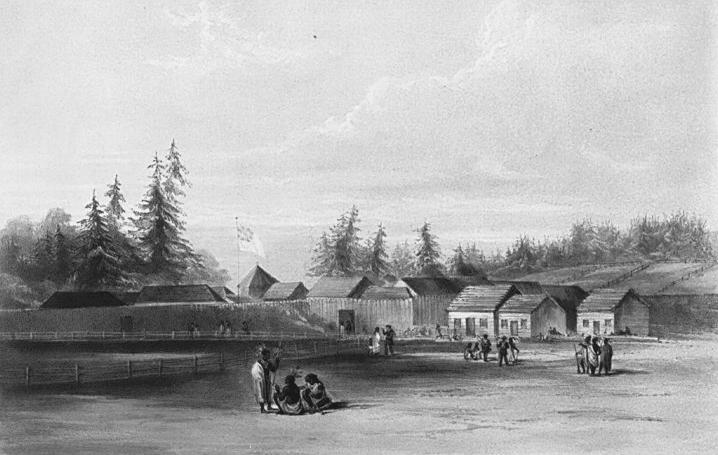
I’ve written about Dr. John McLaughlin in an earlier post. Although British by birth, he was called the “Father of Oregon” because he helped so many American settlers who arrived via the Oregon Trail. He was able to help the Americans because he was chief factor of Fort Vancouver, which was the primary trading post along the West Coast in the 1840s.
Fort Vancouver was founded in 1824 as a fur trading and supply post for the Hudson’s Bay Company. Until the California Gold Rush, Fort Vancouver was the most important settlement along the West Coast, from Alaska to Mexico. It was the headquarters for all Hudson’s Bay Company activities west of the Rockies. Although it remained British until 1846, it made American settlement of the Pacific Northwest possible.
Fort Vancouver was located on the north bank of the Columbia River, in what is today Vancouver, Washington. It is across the river from Portland, Oregon, where the Willamette River flows into the Columbia.
The first fort was built inland to protect it from the frequent floods along the Columbia. Later, however, because of the importance of shipping, a new fort was built closer to the river. It was this second location that became the Fort Vancouver known to the American emigrants and settlers in the Oregon country, and this is the location now reconstructed at the Fort Vancouver National Historic Site.
The fort enclosed around forty buildings, including housing, warehouses, a school, a library, a pharmacy, a chapel, a blacksmith, and a manufacturing facility. Outside the ramparts there was additional housing, as well as fields, gardens, fruit orchards, a shipyard, a distillery, a tannery, a sawmill, and a dairy.
As early as 1825, crops were planted in fields around the fort, including potatoes, peas, and beans. Fruit trees were planted a few years later. The story of how the fruit seeds came to Oregon is delightful:
Apparently, a gentleman in London (probably a Lieutenant Simpson, superintendent of the Hudson’s Bay Company Pacific Coast shipping operation) put the grape and apple seeds from his dessert into a vest pocket one evening shortly before he traveled to the Columbia. When he found the seeds in his pocket, he left them at Fort Vancouver to be planted.
A livestock operation also developed at the fort. By 1825, there were over 100 horses grazing on the plains near the fort. By 1829, there were over 150 cattle, around 200 hogs, and fifty goats at Vancouver.
McLoughlin built a small sawmill near the fort in 1828, but believed that lumbering could produce large revenue for Hudson’s Bay Company. McLoughlin therefore decided to build another mill at Willamette Falls.
By the 1840s when Americans streamed into Oregon, Fort Vancouver was a large commercial operation encompassing not only fur trading but also agriculture, milling and shipping. The farming, fishing and lumbering enterprises operated by Hudson’s Bay Company out of its Fort Vancouver base demonstrated the fertility of the land in Oregon and Washington and gave rise to the great migration along the Oregon Trail. This migration in turn caused the United States to take an interest in the Pacific Northwest, which ultimately led to the U.S. taking over the area from the British.
The first pioneer travelers to Oregon ended their journey at Fort Vancouver. A few years later they built Oregon City upstream on the Willamette River at Willamette Falls. John McLoughlin had already established a lumber mill at that location, so Hudson’s Bay Company had preceded the Americans at the Oregon City location as well as at Fort Vancouver.
Ultimately, in 1846, the Americans and British settled their boundary at the 49th Parallel, and Fort Vancouver transferred to the Americans. Under American rule, the fort still served a military purpose during the Cayuse Wars and it remained a trading post.
The fort was not torn down until the 1860s. Excavation began in the 1940s and is still ongoing. The fort’s location is now a National Historic Site operated by the National Park Service.

For a detailed history of Fort Vancouver and the Hudson’s Bay Company, see the National Park Services website for Fort Vancouver.
Do you think about how commerce and history go hand in hand?




I love the story of how the fruit seeds came to Oregon, Theresa. I always enjoy your Oregon Trail posts.
Thank you, Jill. I love finding the little tidbits of history when I research.
Theresa